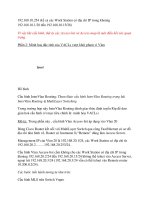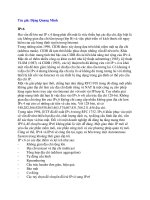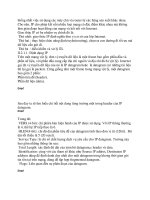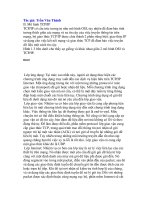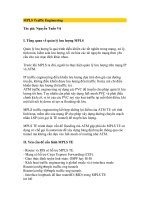Giáo trình Advanced Certificate in Information Technology - Sanlein part 87 ppsx
Bạn đang xem bản rút gọn của tài liệu. Xem và tải ngay bản đầy đủ của tài liệu tại đây (17.65 KB, 6 trang )
print "No\nTry redialing your ISP";
sleep(3);
}
$p->close();
#end listing
******************************************************************
********
From: Question 32
Subject: How do I use tftpdnld via Ethernet port on a 2600?
Press Ctrl+Break on the terminal keyboard within 60 seconds of the power-up
to put the router into ROMMON.
rommon 1 > IP_ADDRESS=172.15.19.11
rommon 2 > IP_SUBNET_MASK=255.255.255.0
rommon 3 > DEFAULT_GATEWAY=172.16.19.1
rommon 4 > TFTP_SERVER=172.15.20.10
rommon 5 > TFTP_FILE=/tftpboot/c2600-i-mz
rommon 6 > tftpdnld
******************************************************************
********
From: Question 33
Subject: How do I setup MultiLinkPPP?
multilink PPP without virtual template
int Multilink1
description multilink bundle
ip unnumbered Loopback0
ppp multilink
multilink-group 1
int Ser0
description first T1 line
encaps ppp
ppp multi
multilink-group 1
int Ser1
description second T1 line
encaps ppp
ppp multi
multilink-group 1
Again, recent software necessary: at least 12.0T or 12.1
or one of the ISP branches (12.0S).
******************************************************************
********
From: Question 34
Subject: How much memory is taken up by BGP routes?
As a reference, please see the following from
I'd like to drill down another level to decide why each entry contains 240 bytes
Tech Tip: How Much Memory Does Each BGP Route Consume?
Each Border Gateway Protocol (BGP) entry takes about 240 bytes of memory in
the BGP table and another 240 bytes in the IP routing table. Each BGP path
takes about 110 bytes.
******************************************************************
********
From: Question 35
Subject: How do I stop my router from looking for cisconet.cfg or
network-config?
Look up "service config" in the manual (available on www.cisco.com if
you do not have a local copy). Turn it off using the command "no service
config" in configuration mode.
******************************************************************
********
From: Question 36
Subject: How do I setup DHCP service on my router?
Here is my 1601 performing as a DHCP server config
The static pool is how I use DHCP to assign the same IP to the same PCeach time,
essentially a static IP address assignment. The only other requirement would be
that on the interface DHCP requests will be received, if you have an inbound ACL,
bootp must be permitted.
ip dhcp excluded-address 192.168.3.1 192.168.3.9
ip dhcp pool dhcp-pool
network 192.168.3.0 255.255.255.0
default-router 192.168.3.1
netbios-node-type b-node
dns-server aaa.bbb.ccc.ddd aaa.bbb.ccc.eee
ip dhcp pool static-pool
host 192.168.3.2 255.255.255.0
client-identifier 0100.00c5.0cbd.7e
client-name main_pc
default-router 192.168.3.1
dns-server aaa.bbb.ccc.ddd aaa.bbb.ccc.eee
******************************************************************
********
From: Question 37
Subject: How do I configure a trasparent proxy redirecting on CISCO router?
>It is possible to configure an trasparent proxy redirecting on CISCO router?
>I would like to redirect all www requests from specific IP addresses to
>other IP address and other port.
A route-map does the IP redirection nicely, I've used it for http and smtp. Not sure
about switching ports simultaneously with the same route map, but you could fix
this with 'ipfw' or similar on the host. Be sure you have 'ip route-cache policy'
enabled to save CPU on the interface. WCCP is another option.
******************************************************************
********
From: Question 38
Subject: How do I use a route-map to limit redistribution in OSPF?
/* match only 172.16.10.x and 172.16.11.0 subnets */
access-list 1 permit 172.16.10.0 0.0.1.255
/* use access-list 1 to determine what gets matched */
route-map LoopbacksOnly permit 10
match ip address 1
/* redistribute connected networks, any and all subnets, */
/* and seed it as E2 type. Note that throughout your */
/* OSPF domain, your loopbacks will have a metric of 20 */
/* 20 is the default metric when you redistribute into */
/* OSPF. Except for BGP routes which get a metric of 1. */
/* Also use the route-map LoopbacksOnly to selectively */
/* redistribute only the ones we want to redistribute. */
router ospf 200
redistribute connected subnets metric-type E2 route-map LooopbacksOnly
******************************************************************
********
From: Question 39
Subject: How do I connect 675 DSL units back to back?
Well I found out that you can hookup other DSL boxes back to back here is
part of an email I found on it:
you need:
'dsl equipment-type CO' on one side and
'dsl equipment-type CPE' on the other
Here is a working example from the lab:
(The distance limitation should be the same
as the one found in the docs)
also, you can run 'debug dsl-phy' a new
command to look at the trainup.
(CO side, an 828)
interface ATM0
no ip address
no atm ilmi-keepalive
dsl equipment-type CO
dsl operating-mode GSHDSL symmetric annex A
dsl linerate AUTO
interface ATM0.1 point-to-point
ip address 1.1.1.2 255.255.255.0
pvc 1/33
encapsulation aal5snap
(CPE side, a SOHO78)
interface ATM0
no ip address
no atm ilmi-keepalive
dsl equipment-type CPE
dsl operating-mode GSHDSL symmetric annex A
dsl linerate AUTO
interface ATM0.1 point-to-point
ip address 1.1.1.1 255.255.255.0
pvc 1/33
encapsulation aal5snap
******************************************************************
********
From: Question 40
Subject: Why can't I upload an IOS image on to my flash on my 2500 router?
> i took one from another 2500, same label E28F008SA and unfortunalely,
> same ERROR MESSAGE while issuing COPY TFTP FLASH from config-reg
> 0x2101
The flash in your system is not recognized by the boot ROM. You can upgrade
your boot ROM (Cisco part BOOT-2500=) or use flash that is compatible (Intel).
******************************************************************
********
From: Question 41
Subject: How do I configure my router so it becomes a DHCP CLIENT?
If you have 12.1(2)T or better and you need:
C800, C100x, C1400, C160x, C17x0, C25xx, C26xx, C36xx, C4x00, C64xx,
C7x00, C8500, and C12000
UBR900, UBR7200
MC3810
The interface command is "ip address dhcp"
******************************************************************
********
From: Question 42
Subject: How do you setup a simple Priority Queuing?
I would take a look at priority queuing, see the link below:
/qos_c/qcprt2/qcdpq.htm
A simple config for your case would be:
priority-list 1 protocol ip high tcp telnet
priority-list 1 default medium
interface Ethernet1
ip address 10.1.1.1 255.0.0.0
no ip directed-broadcast
priority-group 1
******************************************************************
********
From: Question 43
Subject: What are the pro's and con's of using two ISP/BGP providers?
>Why would you use BGP with 2 Internet T1 vs using equal cost
>static routing? What's the pros and cons? Thank you.
The answer in a nutshell is: It depends.
If each T1 goes to a different ISP, then you must use BGP to have the same public
address regardless of route taken.
If each T1 goes to the same ISP and load sharing and ease of setup/management is
more important than availability, then go with static routes.
If the T1 links do not support end-to-end keepalives, go with BGP to avoid black
holes.
If the T1 links go to different POPs of the same ISP, use BGP and indicator routes
to detect ISP segmentation.
If the T1 links go to geographically diverse POPs, then BGP with full or local
routes may improve routing efficiency.
For more detail, see the blurb
(for those reading this out of the archives at a future date, a more detailed version
of this paper will be appearing as a White Paper on my web site, but it will not be
there until late Summer). Chapter 8 of my book walks you through all the
